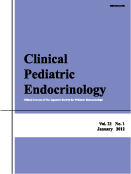All issues

Volume 24, Issue 2
Displaying 1-5 of 5 articles from this issue
- |<
- <
- 1
- >
- >|
Original Articles
-
Naoko Sato, Tomonobu Hasegawa, Yukihiro Hasegawa, Osamu Arisaka, Keiic ...2015Volume 24Issue 2 Pages 37-49
Published: 2015
Released on J-STAGE: May 15, 2015
JOURNAL OPEN ACCESSMale hypogonadotropic hypogonadism (MHH), a disorder associated with infertility, is treated with testosterone replacement therapy (TRT) and/or gonadotropins replacement therapy (GRT) (TRT and GRT, together with HRT hormone replacement therapy). In Japan, guidelines have been set for treatment during adolescence. Due to the risk of rapid maturation of bone age, low doses of testosterone or gonadotropins have been used. However, the optimal timing and methods of therapeutic intervention have not yet been established. The objective of this study was to investigate the current situation of treatment for children with MHH in Japan and to review a primary survey involving councilors of the Japanese Society for Pediatric Endocrinology and a secondary survey obtained from 26 facilities conducting HRT. The subjects were 55 patients with MHH who reached their adult height after HRT. The breakdown of the patients is as follows: 7 patients with Kallmann syndrome, 6 patients with isolated gonadotropin deficiency, 18 patients with acquired hypopituitarism due to intracranial and pituitary tumor, 22 patients with classical idiopathic hypopituitarism due to breech delivery, and 2 patients with CHARGE syndrome. The mean age at the start of HRT was 15.7 yrs and mean height was 157.2 cm. The mean age at reaching adult height was 19.4 yrs, and the mean adult height was 171.0 cm. The starting age of HRT was later than the normal pubertal age and showed a significant negative correlation with pubertal height gain, but it showed no correlation with adult height. As for spermatogenesis, 76% of the above patients treated with hCG-rFSH combined therapy showed positive results, though ranging in levels; impaired spermatogenesis was observed in some with congenital MHH, and favorable spermatogenesis was observed in all with acquired MHH. From the above, we propose the establishment of a treatment protocol for the start low-dose testosterone or low-dose gonadotropins by dividing subjects into two groups to determine different treatment protocols, acquired and congenital MHH, and to conduct them at a timing closer to the onset of puberty, namely, at a timing near entrance to junior high school. We also propose a new HRT protocol using preemptive FSH therapy prior to GRT aimed at achieving future fertility in patients with congenital MHH.View full abstractDownload PDF (855K) -
Devi Dayal, Puneet Jain, Rakesh Kumar, Jaimanti Bakshi, Prema Menon, A ...2015Volume 24Issue 2 Pages 51-57
Published: 2015
Released on J-STAGE: May 15, 2015
JOURNAL OPEN ACCESSThere is scarcity of data on spectrum and outcome of invasive filamentous fungal infections (IFIs) in children with Type 1 diabetes (T1D) from developing countries. A retrospective review of medical records of children with T1D hospitalized with IFI over the past decade at the Pediatric Endocrinology and Diabetes Unit of a large tertiary care hospital of North India was performed with an aim to study their clinical spectrum, hospital course and final outcome. Of the 10 patients studied, nasal/paranasal involvement was seen in 6 and pulmonary involvement in 5 patients. One patient developed disseminated disease. Majority of the identified mycoses belonged to Class Zygomycetes Order Mucorales. Early surgery along with antifungal therapy helped limit the extension of infection and achieve a good outcome in majority of patients. Two patients died; one with a late diagnosis of pulmonary mucormycosis and the other with disseminated disease. The longterm morbidity in the survivors was minimal. In conclusion, rapid diagnosis followed by a multimodal approach involving aggressive surgical debridement, appropriate antifungal therapy and control of hyperglycemic state is the key to good outcome in this otherwise lethal infection.View full abstractDownload PDF (826K)
Short Communications
-
Devi Dayal, L Sindhuja, Anish Bhattacharya, Bhavneet Bharti2015Volume 24Issue 2 Pages 59-62
Published: 2015
Released on J-STAGE: May 15, 2015
JOURNAL OPEN ACCESSA retrospective review of medical records of 80 children with thyroid dysgenesis (TD) was conducted to determine the association of gender and maternal age with TD. The study subjects were attending the Pediatric Endocrinology Clinic of our hospital which is a large tertiary care Multispecialty Pediatric Center located in Chandigarh, Northwest India. There were no gender differences (boys to girls’ ratio 1:1). Mean maternal age of 25.87 ± 4.17 yrs (range 19–35 yrs) was significantly higher as compared to the mean maternal age of 23.87 ± 3.34 yrs (range 18–39 yrs) of a reference group (p < 0.0001). Odds of being older than 30 yrs were higher in mothers of children with TD as compared to mothers of normal children (OR 3.23; 95% CI: 1.54–6.44) (p-value 0.0003). In conclusion, our data shows that advanced maternal age is more prevalent in children with TD.View full abstractDownload PDF (409K) -
Debmalya Sanyal, Sudip Chatterjee2015Volume 24Issue 2 Pages 63-66
Published: 2015
Released on J-STAGE: May 15, 2015
JOURNAL OPEN ACCESSDownload PDF (567K)
Erratum
-
Toshiaki Tanaka, Susumu Yokoya, Yoshiki Seino, Hiroshi Tada, Jun Mishi ...2015Volume 24Issue 2 Pages 67
Published: 2015
Released on J-STAGE: May 15, 2015
JOURNAL OPEN ACCESSVol. 24, No. 1 (2015), p. 19
Fig. 3 should have been as follows: Fig. 3. Changes in BMI-SDS. Fullsize ImageView full abstractDownload PDF (318K)
Fig. 3. Changes in BMI-SDS. Fullsize ImageView full abstractDownload PDF (318K)
- |<
- <
- 1
- >
- >|